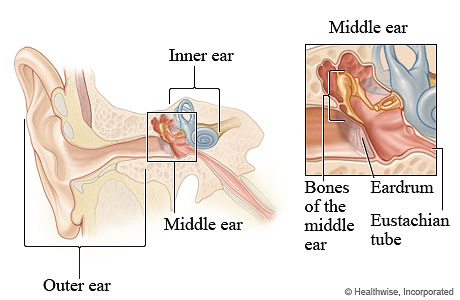Invest In Your Hearing
Middle Ear
Pathologies
Getting the best results
The Middle Ear
A functioning middle ear system is essential to ensuring efficiency of the general hearing process.
The middle ear consists of the tympanic membrane (eardrum), and an air filled chamber containing a chain of three bones (ossicles). The middle ear acts an amplifier of sound, whereas the inner ear (cochlea) acts as a transducer of sound, changing mechanical sound waves into an electrical signal that is then sent to the brain via the statoacoustic nerve (auditory nerve).

At Victorian Hearing, we’re dedicated to providing our patients with a comprehensive range of hearing loss services, including the professional fitting of hearing aid devices. Our university-qualified audiologists have extensive audiological experience, ensuring every patient will receive a perfect fit for the best results.
Symptoms of a middle ear pathology
- A blocked sensation in one or both of the ears
- Discharge of fluid from the ear canals
- Pain in one or both of the ears
- Tinnitus
- A high temperature or fever
Types of middle ear pathologies:
- Otitis Media: This is the medical term for an ear infection or for middle ear inflammation. This condition can occur in one or both ears and generally affects children more often than adults. People generally report a feeling of fullness or having ‘blocked’ The symptoms can either be silent (you’re not aware of any problem), or acute (pain and obvious signs that there is a problem) in presentation.
- Otosclerosis: an abnormal growth of bone in the middle ear.
- Cholesteatoma: a destructive and expanding growth of skin cells growing on the eardrum or the mastoid process.
- Ossicular chain disclocation: a dislocation of part of the chain of the three tiny bones that reside in the middle ear space.
- Direct trauma: trauma to the ear canal or middle ear through an object physically being inserted into the ear canal.
- Temporal bone trauma: may be a fracture to a part of the skull causing conductive hearing loss.
- Congenital malformation of the ossicles: This can be an isolated phenomenon or can occur as part of a syndrome where development of the 1st and 2nd branchial arches is seen such as in Goldenhar syndrome, Treacher Collins syndrome, branchio-oto-renal syndrome etc.
- Superior Canal Dehiscence: Caused by a thinning or complete absence of the part of the temporal bone overlying the superior semicircular canal of the vestibular system. There are numerous cases of symptoms developing after physical trauma to the head.
Diagnosis of middle-ear pathologies
Diagnosis of middle ear pathologies is usually done by an ear, nose and throat specialist (ENT), a general practitioner, or an audiologist. In most instances, you will be required to undertake a hearing assessment to assess the level of hearing loss (if any), and tympanometry, which is an objective measurement of ear drum mobility, middle ear pressure, and middle ear volume, and will provide very useful information in helping differentially diagnose the specific type of middle ear pathology.
Who to contact:
Your GP
Audiologist
Ear, Nose and Throat Specialist (ENT)
Victorian Hearing
Ph: 03 9558 8842
Most middle ear pathologies are treatable, with the associated hearing loss (if any) recoverable back to pre-hearing loss levels, however this is not the case for all middle ear afflictions. You will need to consult with your ENT or GP as to the most suitable course of treatment for your specific middle ear issue.
Mild cases of otitis media may be treatable with paracetamol, however you should always seek advice from your GP before beginning this course of action. More severe cases of otitis media may necessitate antibiotic treatment or surgery to insert pressure releasing tubes into the eardrum.
Other middle ear pathologies such as otosclerosis, a cholesteatoma, or an ossicular chain dislocation may require more in-depth surgeries to prevent further deterioration of hearing. Not all middle ear pathologies require medical intervention, and the fitting of a pair of hearing aids may be recommended on the advice of an ENT.
